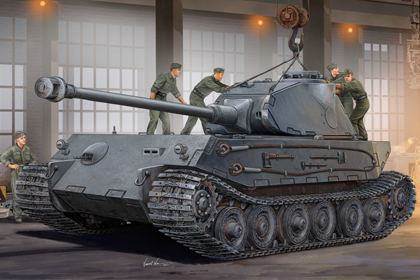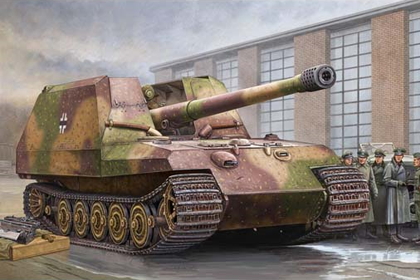![]()
This is the Eduard, photo etch sets for the ‘German Pz.Kpfw.IV Ausf. D/Tauch‘ from HobbyBoss/Tristar.
Detail set |
Tristar |
||||
| (35 944) | Basic | 023 | |||
Source: Eduard
![]()
This is the Eduard, photo etch sets for the ‘German Pz.Kpfw.IV Ausf. D/Tauch‘ from HobbyBoss/Tristar.
Detail set |
Tristar |
||||
| (35 944) | Basic | 023 | |||
Source: Eduard
This is the Trumpeter 05552 kit in 1/35 scale, of the ‘Russian KV-5 Super Heavy Tank’.

Weight was projected as about 100 tons, and the tank was to have 150-180mm of armor. Project development began in June 1941, however was cancelled due to the Siege of Leningrad, in which all developmental operations at the Kirov Plant were halted.
The project fell out of favour from the more advanced heavy tank designs, and no prototype was built.
This is the Trumpeter 01520 kit in 1/35 scale, of the ‘German 3.7cm FlaK 43 Flakpanzer IV – Ostwind’.

Like the “Wirbelwind” the “Ostwind” had a distinctive angular turret, this time six sided, and with the gun emerging from a slot in the pointed front of the turret.
After trials in July, on 18 August 1944 Ostbau were given a contract to produce 100 “Ostwind”. Less than half of these vehicles would be produced – the first fifteen of the eventual total of forty-three were completed in December 1944, far too late to have any impact on the war.
![]()
This is the Eduard, photo etch sets for the ‘German Pz.Kpfw.IV Ausf. C‘ from Tristar/HobbyBoss.
Detail set |
Tristar |
||||
| (35 863) | Basic | ||||
Source: Eduard
This is the HobbyBoss 80130 kit in 1/35 scale, of the ‘German Pz.Kpfw.IV Ausf. C’.

Designed as an infantry-support tank, the Panzer IV was not originally intended to engage enemy armor — that function was performed by the lighter Panzer III. However, with the flaws of pre-war doctrine becoming apparent and in the face of Soviet T-34 tanks, the Panzer IV soon assumed the tank-fighting role of its increasingly obsolete cousin.
The most widely manufactured and deployed German tank of the Second World War, the Panzer IV was used as the base for many other fighting vehicles, including the Sturmgeschütz IV assault gun, Jagdpanzer IV tank destroyer, the Wirbelwind self-propelled anti-aircraft weapon, and the Brummbär self-propelled gun.
This is the HobbyBoss 80131 kit in 1/35 scale, of the ‘German Pz.Kpfw.IV Ausf. B’.

Designed as an infantry-support tank, the Panzer IV was not originally intended to engage enemy armor — that function was performed by the lighter Panzer III. However, with the flaws of pre-war doctrine becoming apparent and in the face of Soviet T-34 tanks, the Panzer IV soon assumed the tank-fighting role of its increasingly obsolete cousin.
The most widely manufactured and deployed German tank of the Second World War, the Panzer IV was used as the base for many other fighting vehicles, including the Sturmgeschütz IV assault gun, Jagdpanzer IV tank destroyer, the Wirbelwind self-propelled anti-aircraft weapon, and the Brummbär self-propelled gun.
This is the Trumpeter 82445 kit in 1/35 scale, of the ‘German VK4502 (P) Hintern’.

The turret and guns were designed by Krupp, the distinctively shaped ‘P2-Turm’ turrets which were designed for these ve1hicles have since been called ‘Porsche’ turrets. As production of these had already started the first 50 KingTiger were fitted with these.
Unfortunately the large armoured ‘lip’ surrounding the turret ring on the Type-180 was not a feature of the Henschel design and resulted in a major shot trap below the mantlet. All later production King Tiger vehicles used the H3-Turm turret, commonly know as the ‘Henschet’ turret.
It seems that one of the Porsche Type-180 vehicles may have been in operation since a Porsche Tiger with an 8.8cm L/71 gun is listed as part of the Panzer Kompanie Kummersdorf on March 1945. Virtually all operational Tiger II tanks, and prototypes were used at the end of the war.
This is the Trumpeter 00378 kit in 1/35 scale, of the ‘German Geschützwagen Tiger für 17cm’.

Complete weight with an 8 men crew was about 60 tons, armor thickness was 30mm at the front and 16mm on the sides, a top speed of 45km/h on roads was possible.
The partly assembled prototype was found in 1945 by allied troops in Haustenbeck near Paderborn.
Brass/metal and Wood detail products from RB Model
Source: RB Model
![]()
This is the Eduard, photo etch sets for the ‘German 12.8cm FlaK 40 Twilling‘ from Takom.
Detail set |
Takom |
||||
| (36 329) | Basic | 2023 | ✓ | ||
Source: Eduard
This is the Takom 2023 kit in 1/35 scale, of the ‘German 12.8cm FlaK 40 Twilling’.

Development of the gun began in 1936, with the contract being awarded to Rheinmetall Borsig, the first prototype gun was delivered for testing in late 1937 and completed testing successfully. The gun weighed nearly 12 tonnes in its firing position, with the result that its barrel had to be removed for transport. Limited service testing showed this was impractical, so in 1938 other solutions were considered.
The eventual solution was to simplify the firing platform, based on the assumption it would always be securely bolted into concrete. The total weight of the system reached 26.5 tonnes, making it practically impossible to tow cross-country. In the end this mattered little, since by the time the gun entered production in 1942, it was used in primary static defensive applications. There were four twin mounts on the fortified anti-aircraft Zoo Tower, and they were also on other flak towers protecting Berlin, Hamburg, and Vienna. Approximately 200 were mounted on railcars, providing limited mobility.
This is the Bronco 35114 kit in 1/35 scale, of the ‘German 88mm FlaK 41 Anti-Aircraft Gun w/Sd.Ah.202 Trailer’.

With the increase of aircraft performance, many armies developed dedicated anti-aircraft guns with a high muzzle velocity – allowing the projectiles to reach greater altitudes. It was this muzzle velocity, combined with a projectile of high weight, that made the 8.8 cm (88mm or “acht-acht”) FlaK one of the great World War II anti-tank guns.
The first such German gun was introduced in 1917, and it used the 88mm caliber, common in the Kaiserliche Marine German navy.